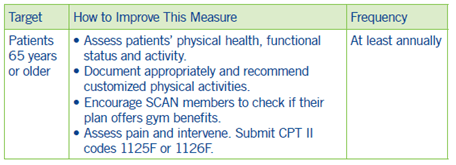Improving, Maintaining and Monitoring Physical Health
Clinical Basis
Multiple factors impact this important and heavily weighted measure, which is captured from the HOS. The HOS question about pain has the highest impact on the score. The other drivers are self-rated health and mobility. Changes are measured over a two-year period.
We recommend a thorough assessment of the above factors as part of the annual wellness exam. Staying active is perhaps the single most important factor in maintaining health. Remaining active improves mobility, reduces pain and improves mood. The mental health of patients is also a factor because the emotional well-being impacts how they perceive their health, how they experience pain and the likelihood of staying active. See Improving or Maintaining Mental Health for more information.

Clinical Guidelines
- Assess and treat pain according to patient preferences—many want non-medication interventions. Understand how pain is impacting daily activities. Learn more about Pain Assessment here.
- Assess mood by using PHQ2 or PHQ9 and intervene. Submit CPT 96127.
- Conduct a Functional Status Assessment to understand whether daily activities are limited by their health in any way.
- Talk to your patients about their level of physical activity and encourage them to start, maintain or increase activity, as appropriate.
- Consider physical therapy for patients with pain or functional impairments.
- Follow up and encourage patients to continue being active.
